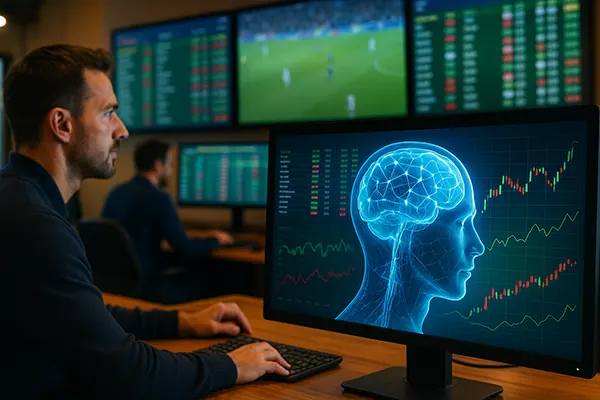How AI Adoption Has Shifted Sportsbook Odds and What It Means for Bettors

Artificial intelligence has reshaped how major sportsbooks set, adjust, and balance their odds. By 2025, leading operators rely on machine-learning engines that review vast amounts of player data, match statistics, betting patterns, and live-game signals within milliseconds. This shift has sparked a key question among bettors: have these improvements made it more difficult to gain an advantage? The following analysis reviews how odds are calculated today, what has changed due to automation, and how those changes influence long-term performance.
AI-Driven Models and the New Foundations of Odds Setting
Sportsbooks now rely on predictive networks capable of assessing probabilities far faster than manual odds teams. These systems continuously compare historical records with real-time inputs, narrowing pricing inaccuracies that were once more common. As a result, opening lines are generally sharper and less prone to early exploitation. Operators also use AI to detect irregular betting flows, helping them stabilise markets against sudden surges that previously created price distortions.
Another major shift is the precision of in-play odds. Machine-learning engines track ball-by-ball or play-by-play events, assessing positional data, momentum indicators, and fatigue patterns. This level of analysis was impossible manually, and it makes in-play betting more dynamic while reducing the gaps bettors could exploit through slower human adjustments. The influence of this automation is most visible in fast-paced sports such as tennis and basketball.
Despite these advances, AI systems still depend on the quality of data they receive. Unexpected factors such as weather changes, emotional pressure, tactical surprises, or referee decisions can still disrupt even the most advanced model. Bettors who follow team news, line-ups, and late updates can still find opportunities when human judgement plays a major role in match development.
How the Balance of Power Has Shifted for Bettors
Many experienced bettors note that value opportunities now appear less frequently, particularly around early pricing. Automated analysis reduces the likelihood of miscalculations that once gave bettors more room to manoeuvre. As limits increase and markets attract more volume, the algorithms learn from real betting behaviour, correcting odds faster than before. This means the window for advantage betting has narrowed considerably.
However, sharper odds do not eliminate the potential for long-term profit. Bettors who specialise in a single league or sport, track micro-level performance patterns, and apply disciplined bankroll strategies still maintain realistic chances of success. AI tools used by sportsbooks are powerful, but they are designed to average outcomes over large samples. Individual matches still produce anomalies that informed bettors can recognise earlier than automated models.
It is also worth noting that not all operators use equally advanced systems. Differences in model quality, data sources, and risk management teams still create inconsistencies across the market. Bettors who compare odds across several providers may notice price discrepancies that remain exploitable when acted upon quickly.
Live Betting: Faster Calculations and Reduced Margins for Error
The most visible transformation has occurred in live betting. AI systems now measure decision-making patterns within seconds, adjusting odds instantly after each significant event. These models evaluate thousands of micro-events per match, including momentum swings, possession pressure, or efficiency changes. This constant recalibration makes it far harder for bettors to rely on outdated or slow odds feeds, which previously offered an edge during fast transitions.
Sportsbooks also deploy AI-powered risk monitoring to track suspicious betting actions. When irregular patterns appear, the system automatically limits markets or pauses betting to prevent exploitation. This creates a more stable market for operators, but it also restricts the chances bettors once had to capitalise on delayed updates or mispriced conditions.
Nevertheless, bettors who understand live dynamics, roster depth, tactical formations, or psychological aspects of competition can still evaluate scenarios that machines interpret only through historical probabilities. This human element remains a meaningful counterbalance to automated optimisation.
Where Bettors Can Still Identify Value in Live Markets
Key value opportunities arise during moments that AI assesses conservatively. For example, when a star player returns from injury earlier than projected, or when a team changes formation mid-match, the algorithm may require additional time to adjust its probability weighting. These windows, while short, still exist and can offer favourable odds.
Emotional and psychological momentum is another factor machines struggle to quantify precisely. Teams fighting relegation, clubs experiencing internal conflict, or players under severe public scrutiny may perform in ways that contradict statistical forecasts. Experienced bettors who follow team narratives can detect shifts before the numbers catch up.
Finally, markets with limited data—such as smaller regional leagues—remain less optimised. AI requires large datasets to form accurate predictions, which means lower-tier competitions often exhibit wider price discrepancies. This allows knowledgeable bettors to find value more easily compared to major leagues where automation is strongest.

Future Developments: How AI May Continue to Reshape Sports Betting
By 2025, AI already dominates odds compilation, but further improvements are expected. Models will integrate more biometric data, advanced positional tracking, and deeper psychological indicators. These enhancements may reduce inaccuracies even further, leaving bettors with fewer mispriced markets. At the same time, transparency standards are rising. Regulators require operators to explain how automated decision-making affects betting limits, settlement times, and pricing mechanisms.
Another emerging trend is the use of reinforcement learning. These systems continuously update their behaviour based on betting outcomes, allowing odds algorithms to “learn” from each match. As these systems advance, sportsbooks may rely even more heavily on fully automated pricing, reducing manual intervention to exceptional situations only.
However, the growing importance of explainability means operators must prove that automated models are fair, safe, and free of discriminatory patterns. Bettors may also benefit from improved data-access tools, allowing them to analyse team statistics and match trends with greater accuracy. This democratisation of data can help offset the competitive advantage that large operators gain from automation.
What Bettors Should Expect Going Forward
Bettors should anticipate a landscape where odds are increasingly efficient, especially in major markets. The challenge of finding long-term profit may grow, but opportunities will still arise from human insight, detailed research, and disciplined strategies. As automation becomes ubiquitous, the ability to interpret context and unexpected developments remains a valuable skill.
Additionally, bettors may see greater personalisation in future odds. Some platforms already test adaptive pricing based on user behaviour, though strict oversight is required to ensure fairness. Transparency rules will play a central role in regulating such systems and preventing potential misuse of personal data.
Ultimately, AI has changed the mechanics of modern sports betting, but it has not eliminated the role of human expertise. While automated models produce more accurate pricing, bettors who combine knowledge, analysis, and awareness of market behaviour can still succeed, even in a more competitive environment.


